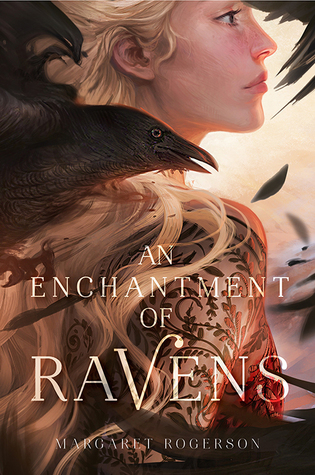
4.5/5 stars
Recommended for people who like: fantasy, magic, Fae, journeys, tricksters, art
I literally had zero idea what to expect from this book since, like Winterwood it was a choice between free books and this was something that I knew was YA fantasy and that I knew other people had enjoyed, so I went with it, which ended up being a good decision.
Isobel is a human whose Craft is painting and, as it turns out, she’s quite good at it. She seems to have a decent head on her shoulders and enjoys making art. She does have somewhat of a tendency to go with the flow when things are tough, but it does work out for her (it is, after all, a book). I did like seeing the kick in her at the end when she got into a spot she really wouldn’t be able to go-with-the-flow her way out of. To be frank, I’m not entirely sure how much of her character I really have a grasp of.
Rook was an odd one. He seems to soften around Isobel when the painting is being done, but then is kind of a dick later on. He then softens again, though it takes Isobel a hot minute to figure this out. Rook ended up actually being a fairly funny character. He’s some Fae prince who’s supposed to be above it all, but he’s also ridiculously vain and proud, making it easy to soothe him by giving false compliments and cooing words. He’s also funny in the way that Fae can sometimes be when writers allow them to take words at face-value and not understand undertones.
There is something akin to instalove here, but I can forgive it mostly because it seems like Rook and Isobel hang out for a while while she’s doing his painting. I think it may only be for a month, but I can pretend that it’s the whole ‘summer’ and thus by the time they start their journey they’re like, what, four months into knowing each other? That’s a better timeline, if only just for a crush and not world-changing love, but it’s certainly more than a lot of characters are given, so I’ll take it.
I also really liked May and March, Isobel’s younger twin siblings, who admittedly aren’t in the book very much. However, the two of them get into shenanigans anytime they are in the book and they have some of the funniest lines/actions in the novel.
Gadfly was another interesting one, though for different reasons. He’s kind of a hard character to get a grasp on, and there’s a couple times when I didn’t really like him, but in the end I think I do like him after all and enjoyed his character. It’s always nice to see a trickster in the midst of things and I’d be curious to see a novella or a short story from his POV as to why he does the things he does.
The scenery was fairly rich and I liked seeing Isobel’s wonder when she finally gets to see a non-summer season. I, personally can’t imagine living without autumn, so I was glad to see that she was awed by the changing leaves and had to admit that it was nice to see something different. I also liked the descriptions of spring, though it’s a similar enough looking season to summer, and how there was clear luxury and danger in both the look and the residents of the Spring Court.
Frankly, while the characters and the setting were decent, I thought the plot was kind of a mess. Rook takes Isobel to be executed for painting a human emotion on his face and then…that isn’t what the story is about anymore. I can understand adding in the plot with Hemlock and the Hunt, raise the stakes and give the characters something to bring them together, right? But then the stuff with the Alder King and the Spring Court was just…weird and didn’t entirely fit, even if I liked it. It almost seemed like Rogerson started out wanting to go one direction then changed her mind halfway through and decided to do something else but forgot to change the setup.
In terms of these Natural Laws (or Ancient Laws? I don’t really remember what they’re called), who enforces them if no one notices they’re broken? Like, are they like regular human laws where someone has to find evidence or a witness that a Law was broken in order for the perpetrators to be punished? If so, literally what is the point of just breaking them and living in a humane enclave or in the World Beyond? Also, what’s the point of the love law if only so that Rook and Isobel have a barrier to getting together?
While a minor point, I’d also like answers about the World Beyond since it’s mentioned a couple times. Is it our world? Like, if they walked into that other place, would there be cars and cellphones? Or would it be a fantasy-typical world where people live in Euro-style villages? Also, does everyone living in the World Beyond know about the Fae? Or is it just the ones who escaped? These questions aren’t super pertinent to the story itself, but they are questions that I had while reading and didn’t really get an answer to.
The strong point of the book was the characters and the scenery. The plots individually were good, but I think they needed something more to hold them together since there seems to be about three stuffed into one book that spends most of its time wandering through the forest. Actually, there’s four plots, but the one with the Hunt and Hemlock just kind of disappears and there isn’t really any answer/conclusion to that at all, so I’m not sure what it was there for if only to force the other three plots along.